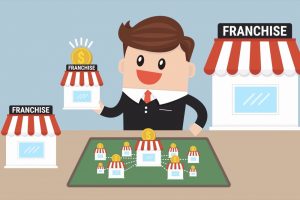Franchises are a Great Business Opportunity in the USA
Looking at some statistics from previous years that highlight the significance of franchise businesses in the U.S. economy.
- Economic Impact: According to a report by the International Franchise Association (IFA), in 2019, the gross domestic product (GDP) of the franchise sector was projected to be $494 billion, accounting for approximately 3% of the total U.S. GDP.
- Employment: Franchises have a significant impact on employment in the U.S. The IFA estimated in 2019 that franchises would provide nearly 8.4 million jobs.
- Number of Franchise Establishments: The number of franchise establishments in the U.S. was projected to reach approximately 785,316 in 2020, according to the IFA’s 2020 Franchise Business Economic Outlook.
- Growth Rates: The franchise sector’s growth rate often outpaces that of the overall economy. For example, the IFA predicted that the number of franchise establishments would increase by 1.5% in 2020, faster than the projected 1.3% growth rate for all businesses.
- Distribution Across Industries: Franchises span various industries, but some of the most common include quick-service restaurants, personal services (like fitness studios or beauty salons), and retail. In 2019, quick-service restaurants alone accounted for over 26% of all franchise establishments.
- Franchise Survival Rate: According to a report from the U.S. Department of Commerce, franchise businesses had a higher survival rate than independent businessesover a period of several years.
- Output: As per the International Franchise Association’s (IFA) Franchise Business Economic Outlook for 2020, the output of franchise businesses was expected to exceed $740 billion, representing about 2.8% of the total United States GDP.
- Sales: Franchises across various sectors, such as retail, food, and services, make a significant contribution to the U.S. economy. For example, the fast-food industry alone, dominated by franchises, was estimated to generate over $200 billion in sales in 2020.
- Entrepreneurship Opportunities: Franchising offers considerable opportunities for entrepreneurship. The IFA estimates that over 300 different types of industries and business categories use the franchising model.
- International Brands: Many franchises operating in the U.S. are home to some of the most well-known global brands. This includes companies like McDonald’s, Subway, and Hilton, which have a massive franchise presence not just in the U.S., but around the world.
- Sector-wise Breakdown: According to data from Statista in 2020, quick-service restaurants were the leading franchise sector by a number of establishments in the United States. This sector was followed by personal services and commercial & residential services.
- Women and Minorities in Franchising: Franchises also offer opportunities for women and minorities. According to a report by FranNet, as of 2018, about 30% of franchises were owned by women, and 20% were co-owned by men and women. Also, minorities own about 30.8% of franchises, as per a report by Franchise Direct in 2020.
- Veterans in Franchising: According to VetFran, a strategic initiative of the International Franchise Association, over 238,000 veterans and military spouses have started careers in franchising since 2011.
- Franchise Export: According to the U.S. Commercial Service, U.S. franchises have been successful at penetrating international markets. As of the last data, U.S. brands were responsible for over half of the franchise systems in operation around the world.
- Startup Costs: Startup costs for franchises can vary significantly depending on the industry and the specific franchise system. For example, according to a 2020 report from Franchise Direct, startup costs for a McDonald’s franchise can range from $1.3 million to $2.3 million, while startup costs for a Subway franchise might range from $116,000 to $263,000.
- Multi-Unit Ownership: Multi-unit franchising is a significant part of the franchise industry. According to FRANdata, as of 2020, more than half of franchise units in the U.S. were owned by multi-unit operators.
- Average Franchise Agreement Length: Franchise agreements usually last between 5 and 25 years, according to a study by Franchise Grade, with the most common duration being 10 years.







